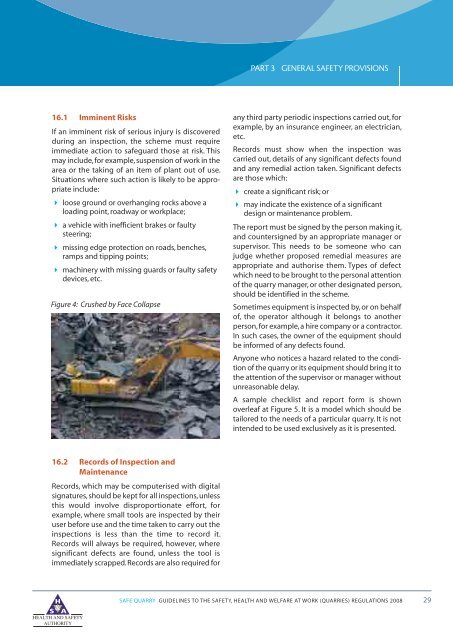Safe Quarry - Health and Safety Authority
Safe Quarry - Health and Safety Authority
Safe Quarry - Health and Safety Authority
You also want an ePaper? Increase the reach of your titles
YUMPU automatically turns print PDFs into web optimized ePapers that Google loves.
PART 3<br />
GENERAL SAFETY PROVISIONS<br />
16.1 Imminent Risks<br />
If an imminent risk of serious injury is discovered<br />
during an inspection, the scheme must require<br />
immediate action to safeguard those at risk. This<br />
may include, for example, suspension of work in the<br />
area or the taking of an item of plant out of use.<br />
Situations where such action is likely to be appropriate<br />
include:<br />
loose ground or overhanging rocks above a<br />
loading point, roadway or workplace;<br />
a vehicle with inefficient brakes or faulty<br />
steering;<br />
missing edge protection on roads, benches,<br />
ramps <strong>and</strong> tipping points;<br />
machinery with missing guards or faulty safety<br />
devices, etc.<br />
Figure 4: Crushed by Face Collapse<br />
any third party periodic inspections carried out, for<br />
example, by an insurance engineer, an electrician,<br />
etc.<br />
Records must show when the inspection was<br />
carried out, details of any significant defects found<br />
<strong>and</strong> any remedial action taken. Significant defects<br />
are those which:<br />
create a significant risk; or<br />
may indicate the existence of a significant<br />
design or maintenance problem.<br />
The report must be signed by the person making it,<br />
<strong>and</strong> countersigned by an appropriate manager or<br />
supervisor. This needs to be someone who can<br />
judge whether proposed remedial measures are<br />
appropriate <strong>and</strong> authorise them. Types of defect<br />
which need to be brought to the personal attention<br />
of the quarry manager, or other designated person,<br />
should be identified in the scheme.<br />
Sometimes equipment is inspected by, or on behalf<br />
of, the operator although it belongs to another<br />
person, for example, a hire company or a contractor.<br />
In such cases, the owner of the equipment should<br />
be informed of any defects found.<br />
Anyone who notices a hazard related to the condition<br />
of the quarry or its equipment should bring it to<br />
the attention of the supervisor or manager without<br />
unreasonable delay.<br />
A sample checklist <strong>and</strong> report form is shown<br />
overleaf at Figure 5. It is a model which should be<br />
tailored to the needs of a particular quarry. It is not<br />
intended to be used exclusively as it is presented.<br />
16.2 Records of Inspection <strong>and</strong><br />
Maintenance<br />
Records, which may be computerised with digital<br />
signatures, should be kept for all inspections, unless<br />
this would involve disproportionate effort, for<br />
example, where small tools are inspected by their<br />
user before use <strong>and</strong> the time taken to carry out the<br />
inspections is less than the time to record it.<br />
Records will always be required, however, where<br />
significant defects are found, unless the tool is<br />
immediately scrapped. Records are also required for<br />
SAFE QUARRY GUIDELINES TO THE SAFETY, HEALTH AND WELFARE AT WORK (QUARRIES) REGULATIONS 2008 29
















